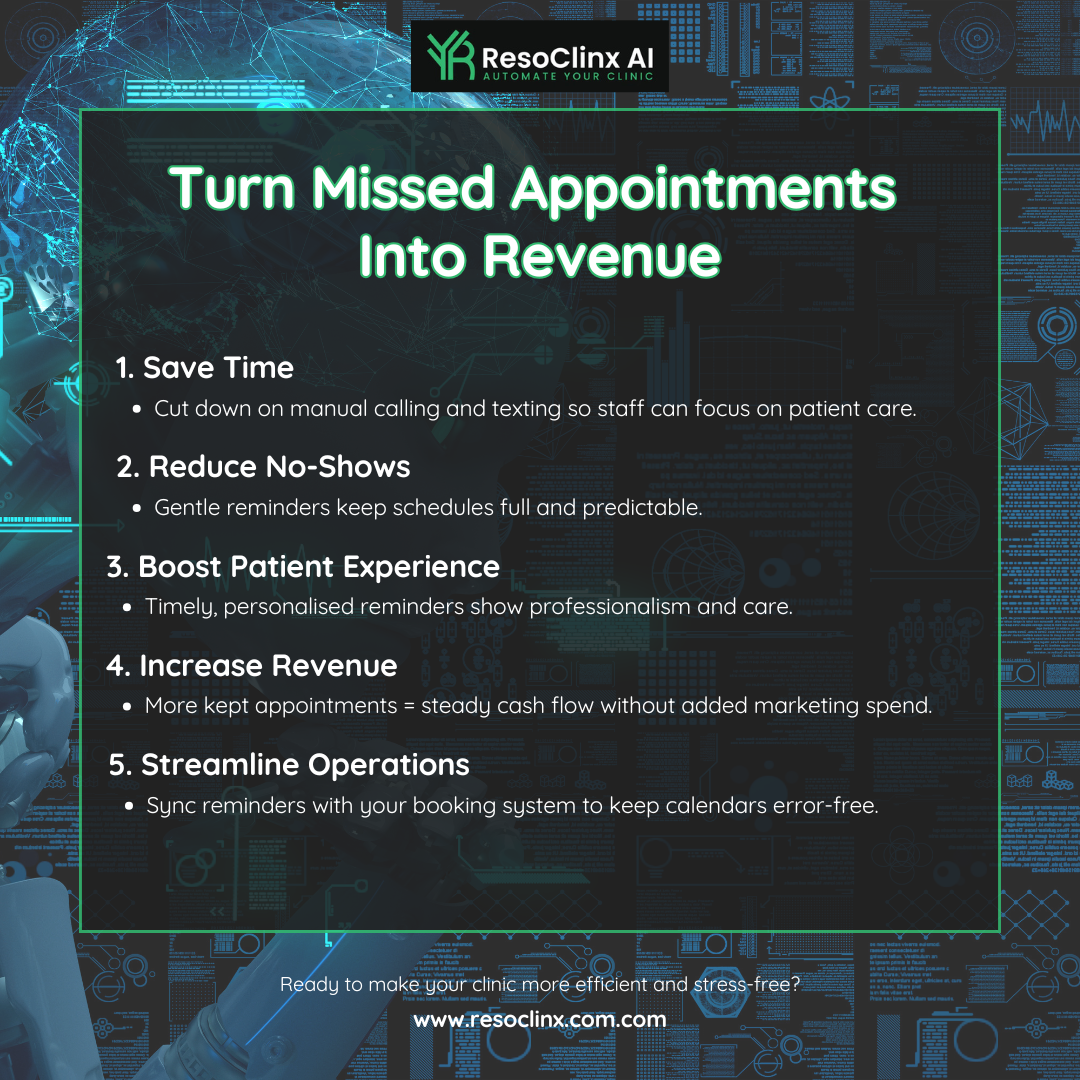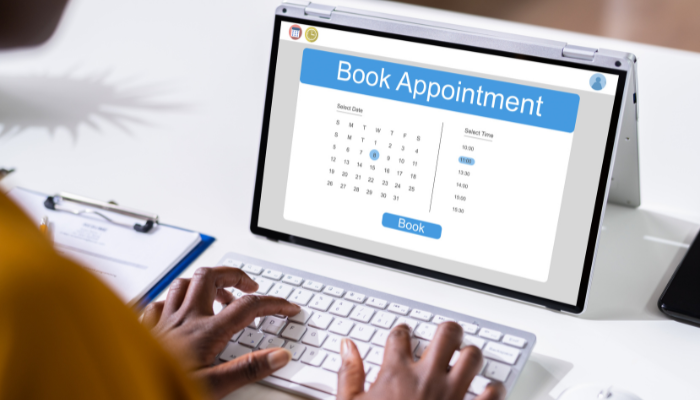Your clinic promises refined results—your communications should, too. Automated reminders are the white-glove touch that keeps calendars full and clients cared for: timely confirmations, prep pointers, one-tap rescheduling, and post-visit follow-ups that nurture loyalty.
Read on to craft a reminder system that feels bespoke, protects staff time, and elevates every appointment into a polished, on-brand experience.
Key Takeaways
- Automated appointment reminders significantly cut down on clients missing their slots, which means less lost income for your clinic.
- Sending out these reminders helps keep clients informed and feeling looked after, making them more likely to be happy with your service.
- By automating the reminder process, your staff spend less time on the phone chasing people and more time on actual patient care.
- It’s important to get the timing and method of your reminders right, using a mix of messages like texts and emails to reach people effectively.
- When setting up these systems, always remember to follow the rules for data privacy, like getting patient consent, to keep everything above board.
Enhancing Clinic Efficiency Through Automated Appointment Reminders

Automated appointment reminders are a real game-changer for aesthetic clinics looking to run more smoothly. They’re pretty much essential if you want to cut down on wasted time and keep your clients happy.
Think about it: forgetfulness or a simple mix-up can lead to a lot of missed appointments, and that’s money and time lost. By using automated systems, clinics can see a significant drop in no-shows, sometimes by as much as 50%.
This means fewer empty slots in the schedule and more predictable patient flow.
Reducing No-Shows and Late Arrivals
It’s a common problem, isn’t it? Clients genuinely forget, or maybe they misread the appointment time. Automated reminders tackle this head-on. Sending out a quick text or email a day or two before an appointment can make a huge difference. Studies show that text messages, in particular, get a good response rate for confirmations.
This proactive approach helps clients remember their commitments, leading to fewer missed appointments and a more organised clinic day. It’s a simple step that can really cut down on those frustrating last-minute cancellations or no-shows.
Improving Client Satisfaction and Engagement
When clients receive timely and relevant reminders, it shows you care about their experience. It’s not just about filling a slot; it’s about making sure they feel looked after. Getting a reminder that includes all the necessary details – like the date, time, and even directions or preparation instructions – helps clients feel prepared and confident.
This kind of communication builds trust and can lead to a noticeable jump in client satisfaction. Happy clients are more likely to return and recommend your clinic to others, which is great for business.
Streamlining Administrative Workloads
Let’s be honest, the admin side of running a clinic can be a lot. Chasing up appointments, confirming details, and rescheduling can take up a significant chunk of your team’s time. Automated reminders take a lot of this pressure off.
When patients can confirm or reschedule their appointments with a simple reply, it frees up your reception staff. They can then focus on more important tasks, like providing direct patient care or managing more complex queries.
This shift means less time spent on repetitive phone calls and more time dedicated to what really matters – your clients.
The Strategic Implementation of Automated Appointment Reminders

Getting automated appointment reminders right is key to making them work for your clinic. It’s not just about sending a message; it’s about how you craft and time those messages to really connect with your clients.
Think of it as a conversation starter, not just a notification.
Crafting Effective Reminder Messages
When you’re writing your reminders, keep it clear and friendly. You want the client to know exactly what the message is about and what they need to do. A good reminder is concise, informative, and includes a clear call to action.
Here’s a breakdown of what makes a message effective:
- Clarity: State the appointment date, time, and location upfront.
- Actionable Information: Tell them what they need to bring or do before their appointment (e.g., fill out a form, avoid certain foods).
- Contact Details: Provide a way for them to easily get in touch if they need to change their appointment.
- Brand Voice: Keep the tone consistent with your clinic’s overall style – professional yet approachable.
For example, instead of a generic “Reminder: Appointment tomorrow,” try something like: “Hi [Client Name], just a friendly reminder about your appointment with Dr. Smith tomorrow, [Date], at [Time]. Please remember to bring your completed intake form. Reply YES to confirm or call us at [Phone Number] if you need to reschedule.”
Designing Tailored Reminder Sequences
One size doesn’t fit all when it comes to reminders. Different clients might prefer different communication styles, and some appointments might need more attention than others. Creating a sequence of reminders, rather than just one, can significantly improve attendance.
Consider a multi-step approach:
- Booking Confirmation: Send an immediate confirmation email or SMS right after the appointment is booked. This reassures the client that everything is set.
- Pre-Appointment Reminder: A reminder sent a few days before the appointment (e.g., 2-3 days) is often ideal. This gives clients enough notice to make changes if needed.
- Final Check-in: A shorter reminder the day before can be helpful, especially for busy clients who might have forgotten.
It’s also worth thinking about personalisation. If a client has a history of late cancellations, you might send them an earlier or more frequent set of reminders. For routine check-ups, a simpler reminder might suffice.
Leveraging Two-Way Communication
Allowing clients to interact with your reminders makes the process much smoother for everyone. Two-way communication lets clients confirm, cancel, or reschedule appointments directly through a simple text message. This cuts down on phone calls and frees up your reception staff.
Here’s how it works in practice:
- Confirmation: Clients can simply reply with ‘YES’ or ‘CONFIRM’ to acknowledge their appointment.
- Rescheduling: Offering an option to ‘Reply R’ to reschedule can direct them to an online booking link or prompt a staff member to call them back.
- Cancellation: A ‘Reply C’ option allows them to cancel, giving you the chance to offer that slot to another client.
This interactive approach not only reduces no-shows but also boosts client satisfaction by giving them more control over their schedule. It’s a simple feature that makes a big difference in clinic efficiency.
Maximising Patient Attendance with Timely Reminders

Getting people to show up for their appointments is a big part of running a smooth clinic. It’s not just about filling slots; it’s about making sure clients get the care they need and that your team’s time is used well.
Forgetfulness or last-minute changes can really mess with your schedule, leading to wasted time and lost income. Automated reminders are a straightforward way to tackle this.
Optimising Reminder Timing and Frequency
When you send reminders, timing is really important. Sending a reminder too early might mean it gets forgotten, while sending it too late doesn’t give people enough time to adjust their plans. A good approach is to send a reminder a few days before the appointment, maybe 24 to 48 hours in advance.
This gives clients a decent window to confirm or reschedule if something comes up. Then, a second, shorter reminder closer to the appointment time can be a good nudge.
- Initial Booking Confirmation: An email or text right after booking helps confirm the details and sets expectations.
- Pre-Appointment Reminder: Send this 24-48 hours before the appointment. It’s a good time for clients to check their schedule.
- Day-Before Reminder: A final, brief message the day before can significantly reduce last-minute cancellations or no-shows.
It’s also worth considering when during the day you send these messages. Messages sent in the late morning or early afternoon often get opened more than those sent during busy morning or evening commute times. Think about your clients and when they’re most likely to check their messages.
Personalising Communication for Impact
Generic reminders are okay, but personalised ones really make a difference. When a reminder includes the client’s name, the specific treatment they’re booked for, and maybe even the practitioner’s name, it feels much more relevant. This personal touch shows you care about them as an individual, not just another appointment.
Personalised communication builds a stronger connection, making clients feel valued and more likely to attend their appointments. It’s a simple step that can greatly improve client satisfaction and reduce the chances of them forgetting.
Utilising Multiple Communication Channels
People have different preferences for how they like to be contacted. Some prefer a quick text message, while others might want an email. Offering a choice or using a mix of channels can be very effective.
For instance, you could send an initial confirmation via email and then a more urgent reminder via SMS.
| Channel | Typical Open Rate | Best For |
|---|---|---|
| SMS | Up to 98% | Quick confirmations, urgent reminders |
| 20-30% | Detailed information, initial booking confirmation | |
| Phone Call | Varies | Complex rescheduling, high-priority clients |
Using SMS is particularly effective because messages are usually read very quickly, often within minutes of being sent. This makes it a great way to get important information across efficiently and encourage a prompt response from your clients.
Ensuring Compliance and Security in Reminder Systems
When you’re sending out appointment reminders, it’s not just about getting people to show up; it’s also about being really careful with patient information.
We all know how important it is to follow the rules, and when it comes to health data, that means paying close attention to things like HIPAA in the US, and similar data protection laws elsewhere. It’s about building trust, and that starts with being responsible.
Adhering to HIPAA and FCC Regulations
It’s really important to make sure your reminder system plays by the book. For instance, under HIPAA, you can’t just send out reminders that include specific health details without getting the go-ahead first. Think about it – you wouldn’t want your personal treatment information floating around unsecured, would you? So, the key is to keep the content of your messages focused on the appointment itself: date, time, and location.
If there’s anything more sensitive, like specific instructions related to a treatment, it’s best to direct patients to a secure patient portal or have them call the clinic directly. Also, remember the FCC rules about communication – you need to be clear about how patients can opt-out of receiving messages.
Obtaining Patient Consent for Communications
Before you even send that first reminder, you absolutely need to get your patients’ permission. This isn’t just a formality; it’s a legal requirement and a good way to show you respect their privacy. You can do this in a few ways.
A common method is to include a clear section on your intake forms where patients can tick a box to agree to receive appointment reminders via SMS or email. Some systems allow for a simple text reply, like ‘YES’, to confirm consent.
Whatever method you choose, make sure you keep a clear record of this consent. It’s your proof that you’re doing things the right way.
Protecting Patient Data with Secure Platforms
Choosing the right technology makes a huge difference here. You want a system that’s built with security in mind. Look for platforms that use encryption to keep data safe during transmission. This means that even if someone managed to intercept a message, they wouldn’t be able to read it.
It’s also wise to use systems that have access controls, so only authorised staff can see patient information. Regular checks and updates to your system are also a good idea. Think of it like locking your front door – you want to make sure all the entry points are secure.
Here’s a quick rundown of what to look for:
- Encryption: Data should be protected during transit.
- Access Controls: Only authorised personnel can view sensitive data.
- Audit Trails: The system should log who accessed what and when.
- Secure Storage: Patient data needs to be stored safely.
Being proactive about security and compliance isn’t just about avoiding trouble; it’s about building a reputation for trustworthiness. When patients know their information is safe with you, they’re more likely to feel confident and continue coming back.
Integrating Automated Reminders with Practice Management
Making automated appointment reminders work smoothly with your existing practice management system is key to really getting the most out of them. It’s not just about sending a text; it’s about making sure all your systems talk to each other properly.
When this happens, it frees up your staff and makes things much easier for everyone.
Seamless Software Integration for Data Flow
To get this working well, your reminder system needs to connect with your patient database and scheduling software. This connection means that when an appointment is booked or changed, the information automatically flows to the reminder system.
No more manual data entry, which saves time and stops those annoying mistakes from happening. Think of it like this: a new appointment gets added, and bam, the reminder is scheduled without anyone lifting a finger.
This smooth data flow is the backbone of an efficient system.
Utilising Platforms for Comprehensive Management
Many modern practice management platforms now include built-in or easily integrated automated reminder features. These systems often go beyond just sending reminders. They can help manage online bookings, track patient communication history, and even integrate with other tools you might use, like accounting software or patient portals.
Having everything in one place makes managing your clinic much simpler. It means you can see a patient’s entire journey, from booking to follow-up, all within a single system.
The Role of Automation in Revenue Recovery
Automated reminders aren’t just about convenience; they can actually help bring in more money. By reducing no-shows, you’re not losing out on appointment slots. For example, a clinic might see a significant drop in missed appointments, meaning more billable hours.
Some systems even allow patients to confirm or reschedule directly via text, which can help fill last-minute cancellations quickly. This proactive approach to managing appointments directly impacts your clinic’s revenue and makes your schedule more predictable.
Here’s a quick look at how it can help:
- Reduced No-Shows: Fewer missed appointments mean more revenue.
- Filled Cancellations: Two-way communication allows for quick rescheduling, filling gaps.
- Improved Staff Efficiency: Less time spent on manual reminders means more time for patient care.
Integrating your reminder system with your practice management software is like giving your clinic a super-efficient upgrade. It connects the dots, making operations smoother and helping you keep more of the revenue you’ve earned.
The Benefits of Proactive Client Communication
Staying in touch with your clients before, during, and after their appointments is a really smart move for any aesthetic clinic. It’s not just about reminding them when they’re due for a visit; it’s about building a relationship and making sure they feel looked after.
When you communicate proactively, you’re essentially setting the stage for a positive experience, right from the moment they book.
Building Trust Through Consistent Engagement
When your clinic consistently reaches out with helpful information or timely reminders, it shows clients that you care about their journey. This regular contact helps build a strong sense of trust.
Think about it: if you’re getting useful tips about aftercare or a friendly reminder about an upcoming appointment, you’re more likely to feel confident and valued by the clinic. This consistent engagement can turn a one-time visitor into a loyal client who feels connected to your practice.
- Personalised check-ins: A quick message asking how they’re doing post-treatment can make a big difference.
- Relevant advice: Sending out seasonal skincare tips or information about new treatments that might suit them.
- Appointment confirmations: Simple confirmations reassure clients that their booking is secure.
Proactive communication isn’t just about filling slots; it’s about nurturing client relationships and demonstrating a commitment to their well-being and satisfaction throughout their entire experience with your clinic.
Reducing Scheduling Conflicts and Confusion
Let’s face it, life gets busy, and it’s easy for appointments to slip people’s minds. Automated reminders are brilliant for cutting down on those awkward moments when a client forgets they had an appointment or turns up at the wrong time.
By sending out clear, timely notifications, you significantly reduce the chances of missed appointments and the administrative headache that comes with them. This also means fewer scheduling mix-ups for your front desk staff, allowing them to focus on providing excellent service rather than chasing confirmations.
Here’s how proactive communication helps:
- Reduces no-shows: Clients are reminded of their appointments, decreasing the likelihood they’ll forget.
- Minimises late arrivals: Timely reminders can include travel advice or parking information, helping clients arrive on time.
- Lowers administrative burden: Less time spent on manual phone calls for confirmations and rescheduling.
Empowering Patients with Information
Providing clients with the right information at the right time is incredibly important. This could be anything from detailed pre-treatment instructions to helpful aftercare advice. When clients feel well-informed, they’re more likely to feel confident about their treatment and understand what to expect.
This reduces anxiety and helps them achieve the best possible results. For example, sending a follow-up email with specific aftercare instructions after a procedure can prevent complications and improve the overall outcome, making the client feel supported even after they’ve left the clinic.
Streamlining Your Clinic with Automated Reminders
So, we’ve looked at how automated appointment reminders can really make a difference for your aesthetic clinic. It’s not just about cutting down on those pesky no-shows, though that’s a big win. It’s also about making things smoother for your clients and freeing up your team’s time.
Fewer missed appointments mean more consistent income and happier clients who feel looked after. Implementing these systems might seem like a technical step, but the payoff in efficiency and client satisfaction is well worth the effort. It’s a smart move that helps your clinic run better and keeps your clients coming back.
Frequently Asked Questions
How do automated appointment reminders help my clinic?
Automated reminders are like having a super-efficient assistant! They send messages to your clients about their upcoming appointments. This means fewer people forget and miss their slots, which saves your clinic time and money. Plus, it helps clients feel more organised and looked after.
What's the best way to send reminders?
Text messages (SMS) are usually the best way because most people check their phones regularly. Emails are good too, but sometimes they get lost in spam. Sending a reminder a day or two before the appointment is a good rule of thumb.
Can clients reply to these reminders?
Yes, definitely! When clients can reply to confirm, change, or cancel their appointment, it makes things much easier for everyone. It means your staff don't have to spend as much time on the phone and can focus on other important tasks.
What information should be in a reminder message?
Keep it simple but include all the important bits: the date and time of the appointment, the clinic's name and address, and maybe a contact number in case they need to get in touch. Personalising it with their name is a nice touch too!
Are these reminder systems safe for patient information?
It's really important to use systems that follow strict rules, like HIPAA in the UK and other countries. This means your patient's private information is kept safe and secure. Always check that the system you use is compliant.
How often should I send reminders?
A good approach is to send one reminder a few days before the appointment and maybe a final quick one the day before. This helps make sure the client doesn't forget, but you don't want to send too many messages and annoy them.






